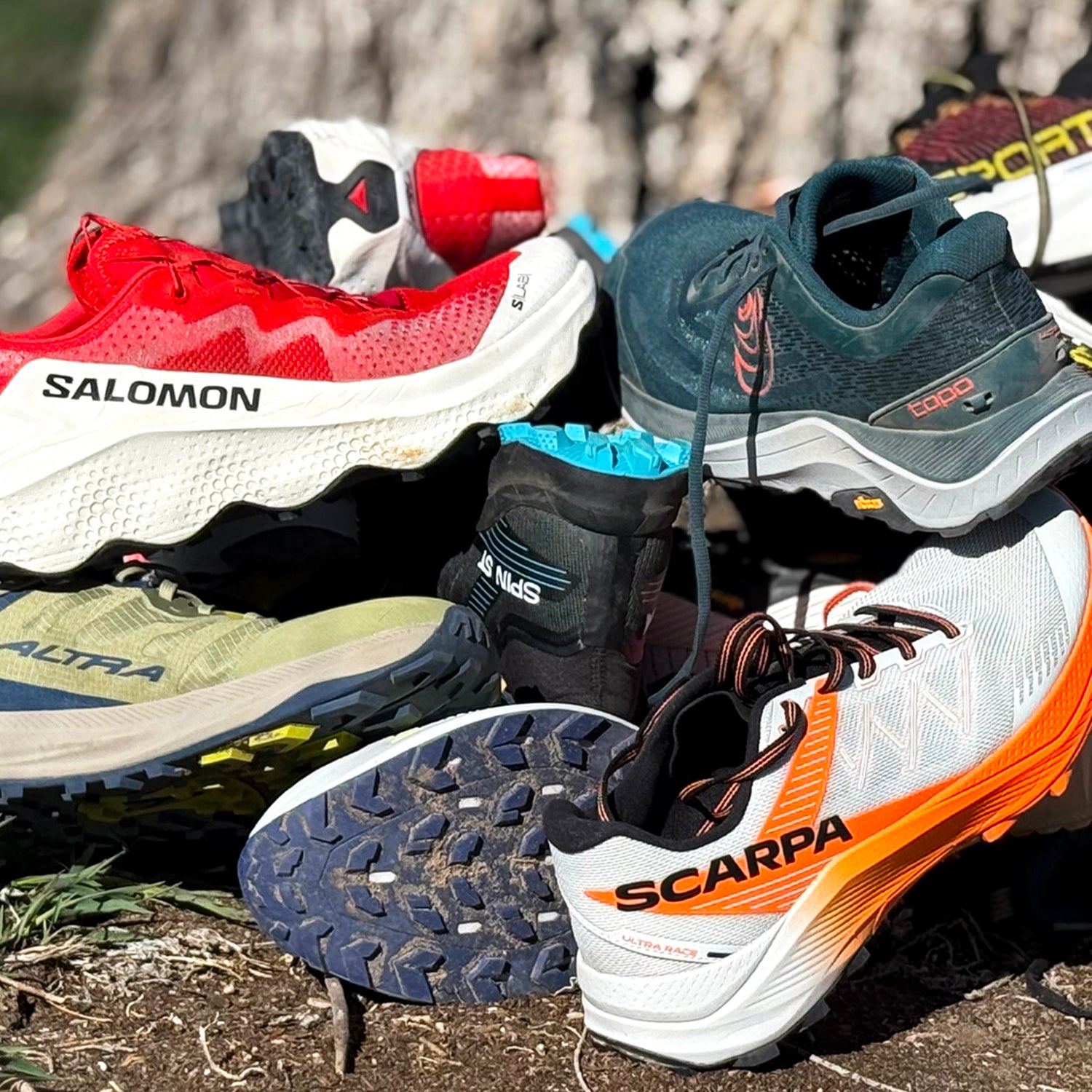Trails are portals to adventure, and good trail running shoes enable you to safely, confidently, and comfortably experience those trails, whether it’s a mellow, packed path or a rock-strewn mountainside. We’re constantly researching, testing, and comparing new releases with the tried-and-true. Our test team runs on rutty Santa Barbara bluffs, rocky Colorado peaks, sage-strewn Nebraska sandhills, and soggy Virginia forest pathways, to name a few terrains. After miles and miles (and miles) of trails, these are the shoes that have risen to the top.
Update June 2025: We’ve tested and selected new models in four categories, including a new best max-cushioned shoe and a new best daily workhorse. We also added runner-up picks in the growing categories of trail running supershoes and road-to-trail. We are continually testing and will be updating this list of best trail running shoes throughout the year as new models impress our testers and editors.
At a Glance
- Best All-Around: Salomon S/Lab Ultra Glide ($250)
- Runner-Up All-Around: La Sportiva Prodigio Pro ($195)
- Best Trail Super Shoe: Adidas Agravic Speed Ultra ($220)
- Runner-Up Trail Super Shoe: Puma Deviate Nitro Elite Trail ($230)
- Best for Ultrarunning: Hoka Tecton X 3 ($275)
- Best Daily Workhorse: Mount to Coast T1 ($180)
- Best Value: Saucony Peregrine 15 ($140)
- Best Zero Drop: Altra Lone Peak 9 ($140)
- Best for Speedy Scrambles: Merrell MTL Long Sky 2 Matryx ($112)
- Best for Soft Terrain: Scarpa Spin ST ($179)
- Best for Groomed Trails/Gravel: The North Face Vectiv Enduris 4 ($160)
- Best Road-to-Trail: Nike Pegasus Trail 5 ($140)
- Runner Up Road-to-Trail: Craft Nordlite Ultra 2.0 ($180)
- Best Max Cushioned: Nike Wildhorse 10 ($165)
- Best Natural Ride: Topo Athletic Ultraventure 4 ($150)
- Best for Beginner Trail Runners: New Balance Fresh Foam X Hierro v9 ($155)
- How to Choose a Trail Running Shoe
- How We Test
- Meet Our Lead Testers
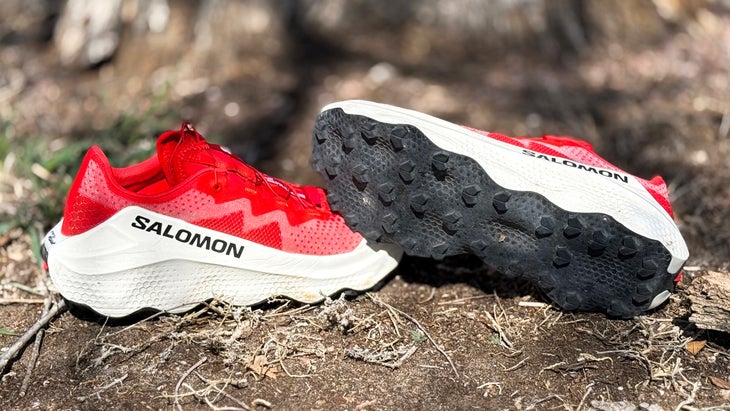
Best All-Around
Salomon S/Lab Ultra Glide
$250 at Backcountry $250 at Salomon
Weight: 10.2 oz (unisex)
Stack Height: 41–35 mm
Drop: 6 mm
Sizing: 4.5-13, 14 (men’s), 5.5-14, 15 (women’s)
Pros and Cons
⊕ Unmatched combo of comfort and trail performance
⊕ Quick-feeling for such a cushioned shoe
⊕ Outstanding grip
⊗ Quicklace system is difficult to adjust
Thick soles typically feel unstable on rocky, rooty trails, sloped surfaces, or sharp descents. But the Salomon S/Lab Ultra Glide defies expectations, delivering a surprising blend of cushioning, stability, and responsiveness. “I’m always a little wary of big-stack trail shoes because some of them feel mushy and slow, or even worse, unstable,” said one tester. “These were none of those. I felt like I nestled right into the soles and bounced right along.”
Aesthetically, the S/Lab Ultra Glide looks like no other. The funky-looking wavy midsole with ankle-deep sidewalls combines a chassis of firmer EVA for stability with a softer, bouncier PEBA/EVA core underfoot. The outsole molds to the wavy midsole, creating circular indents across the bottom of the foot, designed to defuse impact. The combination works: the shoe delivered a soft, responsive, and adaptable ride that morphed over uneven terrain. On the open trail, the four-millimeter lugs proved reliable, biting into packed dirt and loose gravel with ease.
“The shoe provided a smooth, supported run on a variety of terrains,” noted one tester, who was surprised that even when the footing got rocky, the S/Lab Ultra Glide “delivered a commanding performance, allowing for precise, responsive running.”
The soft but strong engineered mesh upper molded and moved with the contours of the foot, while providing a slight stretch for added toe box room. The gusseted tongue snugged our insteps nicely, but Salomon’s signature Quicklace system takes some adjusting each time you lace up to get the proper amount of pressure—not a dealbreaker, but not quite an effortless “set it and forget it” experience.
Once dialed in, however, the fit and ride topped every shoe in this year’s test selection, making them the shoes we always seemed to reach for.
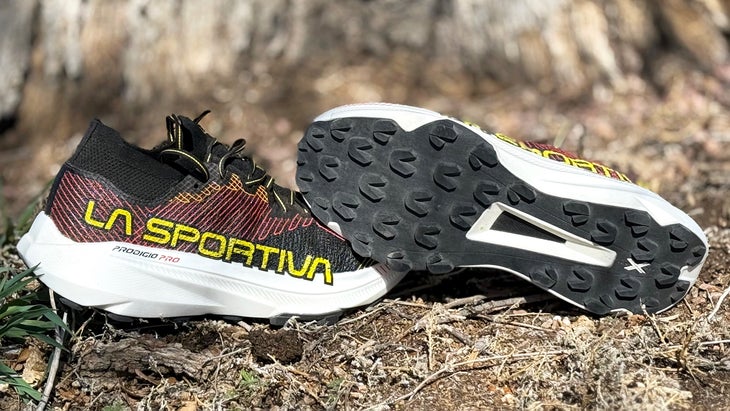
Runner-Up All-Around
La Sportiva Prodigio Pro
$195 at REI $195 at La Sportiva
Weight: 8.9 oz, 7.9 oz
Stack height: 34–28 mm
Drop: 6 mm
Sizes: 7.5-15.5 (men’s), 5.5-11 (women’s)
Pros and Cons
⊕ Lively midsole that still allows ground feel
⊕ Great traction
⊗ Some pressure on the top of the foot
The Prodigio Pro runs unlike any other La Sportiva shoe we’ve ever tested. We’ve enjoyed many from the brand, known for its nimble, rugged trail models. But this one is the softest to date and delivers a remarkably lively, fun ride. The midsole—a core of bouncy, nitrogen-infused TPU surrounded by a more stable, nitrogen-infused EVA cage—feels snappy underfoot. “Your foot just pops off the ground with each step,” said one tester.
The bootie construction—a sock-like, engineered mesh upper encircling the ankle—successfully kept trail debris from sneaking inside the shoe. The durable upper, made from a mix of polyester, TPU, and nylon threads that the brand is calling “Power Wire” mesh worked in conjunction with the secure midfoot wrap to hold our feet securely and comfortably. One knock on the upper: The tongue, with an interesting, tubular padding, caused a little irritation on the top of the foot beneath the laces for some testers. Most, however, found it a comfortable upper overall, one that was a pleasure to pull on.
Underfoot, a Frixion outsole with multidirectional, four-millimeter lugs did a fantastic job at gripping all surfaces. “This shoe has great traction in mud, slush, dirt, rocks, and roots,” said one tester, who noted that the shoe performs expertly on off-camber terrain. “This shoe makes me feel more nimble and quick than most shoes do.”
Read our full review of the La Sportiva Prodigo Pro
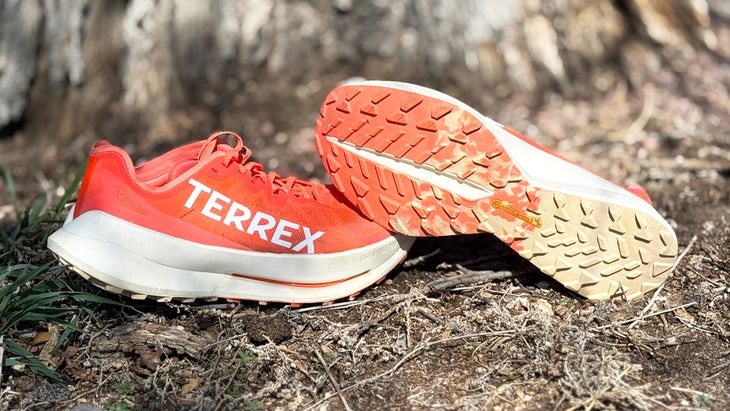
Best Trail Super Shoe
Adidas Terrex Agravic Speed Ultra
$220 at REI $220 at Backcountry
Weight: 9.5 oz (men’s), 8.1 oz (women’s)
Stack Height: 38–30 mm
Drop: 8 mm
Sizing: 6-13, 14 (men’s), 5-11 (women’s)
Pros and Cons
⊕ Fast, smooth, and lively ride
⊕ Adaptive stability
⊗ Not great in really rocky terrain
Every Agravic Speed Ultra tester was in awe of how easily faster paces felt while wearing this shoe. “I consistently ran about 30 seconds per mile faster while running in these shoes than what the effort felt like,” said a masters tester. Adidas designers skillfully adapted the elements of a road super shoe to create a similar, effort-reducing, propulsive feel in a shoe that works on the uncertain terrain of the trail.
Underfoot, the main ingredients are a bouncy-but-not-too-soft gas-infused TPEE-based midsole working harmoniously with an embedded, trail-specific “plate.” Instead of a solid, rigid plate, Adidas uses semi-flexible rods that react independently to variations in the terrain. Made of PEBA in its hard plastic form as often found in track spike plates, the four prongs in the forefoot and two in the heel are splayed wider and closer to the edges than those in Adidas’s road shoes, to enhance stability. One tester said the resulting ride “provided a lively pop without being tippy on variable surfaces or prescribing a set, rigid roll.”
Deep sculpted side walls surround a beveled heel, delivering smooth, secure landings, and a narrow midfoot waist widens to a generous, flared forefoot, providing an agile and stable stance. The aggressively rockered geometry from heel to toe delivers what one tester described as “a balanced ride that makes it easy to stay forward on my feet and drive backward with each stride, creating a quick, powerful push-off.”
For the outsole, Adidas uses the same trustworthy, grippy Continental rubber found on most of the brand’s running shoes. This trail-specific version features variable 2.5- to 3-millimeter lugs for surefooted, no-stress traction. As one might expect in a high-level racing shoe, the upper is kept to a minimum for weight reduction. Made with a non-stretch, breathable, quick-drying, woven material, we found it offered a secure, snug lockdown while providing a touch of abrasion protection.
Given the tall stack height, testers had to cautiously check their foot placements through technical rocky terrain. But wherever the terrain smoothed out and allowed for full strides, the Agravic Speed Ultra came alive and delivered a ride that testers said felt like flying. If you’ve been holding out for a plated trail racing shoe that gets almost everything right, the wait is over.
Read our full review of the Adidas Terrex Agravic Speed Ultra.
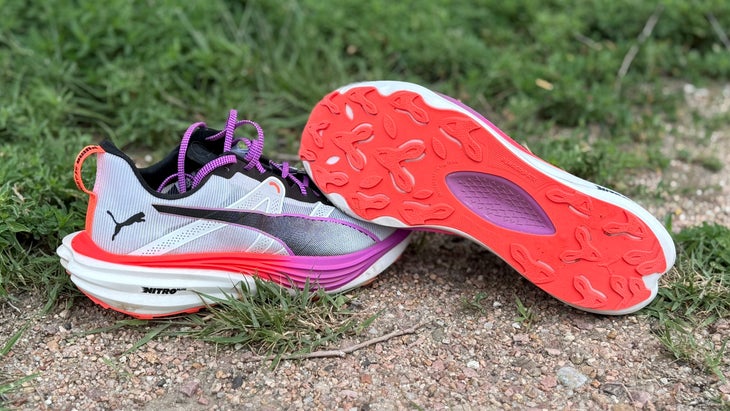
Runner-Up Trail Super Shoe
Puma Deviate Nitro Elite Trail
$230 at Running Warehouse $230 at Puma
Weight: 8.6 oz (men 9, women’s 10.5)
Stack Height: 36–30 mm
Drop: 6 mm
Sizing: 7-13, 14 (men’s), 5.5-11 (women’s)
Pros and Cons
⊕ Bouncy and responsive
⊕ Breathable, hydrophobic upper
⊕ Stable for a shoe this cushioned
⊗ Tight and narrow fit
⊗ Poor grip
Building off the Puma Deviate Nitro Elite, one of Puma’s top-selling racing shoes, the Puma Deviate Nitro Elite Trail successfully brings road super shoe tech to the dirt. “It feels like a springboard. Super light and bouncy,” said one tester.
According to Conor Cashin, a senior product line manager at Puma running, the shoe’s magic stems from a new nitrogen-infused midsole foam called Aliphatic TPU that provides a more responsive ride than even PEBA, the industry standard to date, “Overall, you get a more energetic and ‘faster’ feeling in the Aliphatic TPU,” claims Cashin. After runs in the shoe, one tester said: “The foam feels like it is gathering energy as soon as my weight starts to compress it and then rebounds at just the right time and location.”
Embedded in the energetic foam is a full-length carbon-composite fiber plate engineered to have more torsional flexibility for the trail. Cashin says the plate is designed “to give you some stiffness in the shoe and some propulsion where you need it, but not going to hinder you or potentially make it more difficult to run on the trail with those different surfaces, roots, rocks, up and down.”
Our testers confirmed the plate’s effectiveness. In tandem with the bouncy foam, it produced a “super lively, great ride with huge energy return,” noted one tester. While the ride feels most efficient at higher speeds and cadences, testers reported that it works well at slower paces, too.
Despite a 36-millimeter heel, the Deviate Nitro Elite feels remarkably stable and runs more like a lower-profile shoe, thanks to the responsive foam (which keeps it from being squishy), the adaptable plate, the balanced, six-millimeter drop (two millimeters less than the Deviate Elite 3), and a slightly straighter shape than the road racer. All of which allowed the shoe to perform surprisingly well in moderately technical terrain.
The upper is constructed with an airy, durable weave featuring built-in reinforced strips for a vise-like hold. Every tester remarked on the snug, narrow fit, which most thought offered a precise sense of control and confidence while allowing enough room for comfort, especially in the toe box. One tester, who prefers wider-toe boxes, described the fit as akin to a track spike: “skinny, tight, and compressed.”
For the outsole, Puma uses its proprietary rubber compound paired with shallow 3-millimeter lugs, which testers found ideal for hard-packed, smooth trails. “On dusty flats, they feel like rocket ships,” said one California-based tester. But in mud, it’s a different story; they turn into what one called a “Slip-N-Slide.”
While not suited for every runner or trail, the Deviate Nitro Elite Trail impressed all our testers for its fun, super-shoe ride, especially when ripping through flat, fast races up to 50K and speed-focused training runs.
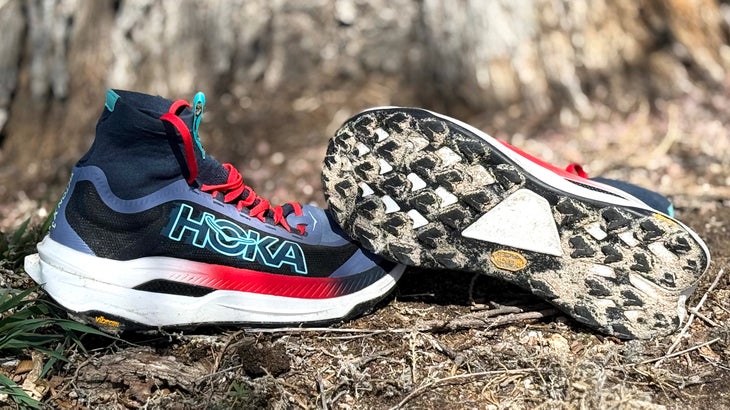
Best for Ultrarunning
Hoka Tecton X 3
$275 at REI $275 at Running Warehouse
Weight: 10 oz (men’s), 7.9 oz (women’s)
Stack Height: 40–35mm (men’s); 39–34mm (women’s)
Drop: 5 mm
Sizes: Men’s 7-14, Women’s 5-11
Pros and Cons
⊕ Gaiter keeps out trail debris
⊕ Excellent balance of comfort and responsiveness
⊕ Doesn’t feel tippy, despite carbon fiber plates
⊗ Pricey
This third iteration of Hoka’s Tecton X is the best yet (and we’ve loved them all, awarding the debut model Gear of the Year in 2022). Like the first two, the Tecton X 3 features two carbon fiber plates within each shoe that sit parallel to each other, allowing them to move independently. This enables the shoe to morph over rocks and roots instead of tipping the foot, a sensation we’ve felt in some trail running shoes that utilize one large plate. The two plates in the Tecton X 3 are slightly wider than those in version 2 and feature a winged shape under the heel that’s meant to add to the shoe’s stability on technical terrain.
Other updates include a softer layer of PEBA foam above the plate and directly beneath the foot which testers reported enhances the joint-comforting cushion over long, rugged runs. The bottom layer of foam remains firmly responsive for a tactile ground feel.
And then there’s the unique upper. While some testers were skeptical of having a gaiter built into the shoe, it proved not only comfortable but also highly effective. A tester who worried the material around the ankle would annoy her reported, “The gaiter is stretchy and adds to the overall comfort and techy feel.” Every tester appreciated how the built-in gaiter kept debris out of the shoes with zero irritation or awkward clips. The Matryx upper, made of high-strength synthetic yarns, was stretchy enough for easy on-and-offs and to move with the foot, while also doing a great job holding feet in place over wild terrain. Its also highly breathable: “I ran straight through a river, and the shoe dried out very quickly,” said a Boulder, Colorado-based tester.
The entire package—two layers of foam, four-millimeter Vibram Magagrip lugs, carbon-fiber plating, and a gaiter—comes in at minimal weight for such a rugged and feature-rich ride. “This thing is light, especially for a trail shoe,” marveled a female tester, adding, “It’s absolutely speed-inspiring.” The Tecton X 3 is our pick for ultra-runners and regular folks looking for a great shoe that can tackle the most mountainous terrain in comfort.

Best Daily Workhorse
Mount to Coast T1
$180 at Mount to Coast (Women’s) $180 at Mount to Coast (Men’s)
Weight: 9 oz (men 9, women’s 10.5)
Stack Height: 36–32 mm
Drop: 4 mm
Sizing: 7-13 (men’s), 5.5-11 (women’s)
Pros and Cons
⊕ Lightweight and nimble ride
⊕ Custom-fit dual lacing system
⊗ No lace garage for lower pull cord
After successfully bursting onto the road shoe scene less than two years ago, the T1 is Mount to Coast’s first foray into trail running shoes. The T1 takes the brand’s standout features from its road lineup—a responsive, long-lasting midsole and an independently adjustable lacing system—and tuned it for off-road performance.
Underfoot, the nitrogen-infused PEBA-based midsole offers a touch of bounce, enough to be responsive but not so much that it feels unstable or out of control on the trail. Despite a substantial 36-millimeter stack height at the heel, testers felt surprisingly connected to the ground, allowing for confident, nimble movement through uneven and unpredictable footing. The Litebase Vibram Megagrip outsole with four-millimeter lugs bit into a variety of surfaces, from loose gravel to slick rock, giving us a Velcro-like, confident grip. One tester reported, “I absolutely battered it on technical terrain.”
Unique to Mount to Coast is a dual pull-cord lacing system that lets you independently adjust the fit in the toe box and midfoot for customized lockdown and comfort. Initially, it took testers some jostling to fine-tune the fit of the two-part laces, but once dialed in it allowed a level of customization regular laces simply can’t match Complementing the fit from the innovative laces is the shoe’s well-crafted shape that follows the contours of the foot. “The baseline chassis of the shoe is so well tailored that even a laceless shoe would perform well,” one tester noted.
The only gripe? A lack of a lace garage to stash the excess cord from the lower half.
Read our full review of the Mount to Coast T1.
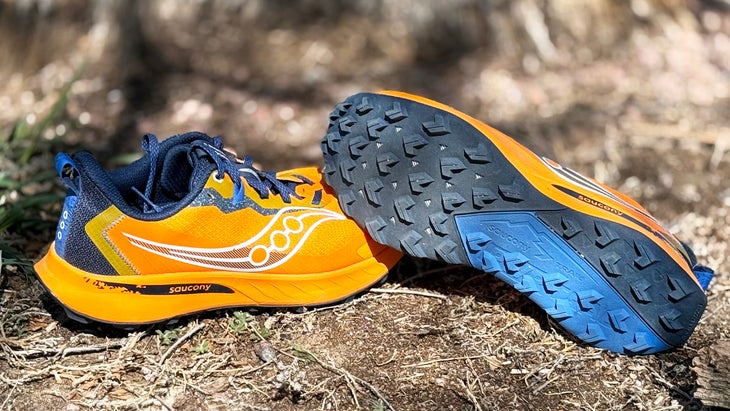
Best Value
Saucony Peregrine 15
$140 at REI $140 at Backcountry
Weight: 9.7 oz (men’s), 8.6 oz (women’s)
Stack height: 28–24 mm
Drop: 4 mm
SIZES: 7-13, 14, 15 (men’s); 5-12 (women’s)
Pros and Cons
⊕ Performance features at a reasonable price
⊕ Light, flexible, and nimble ride
⊕ Deep outsole lugs
⊗ Forefoot cushioning can feel slight on long runs
In an era that’s serving up increasingly fat midsoles, we’re happy to see that Saucony’s longtime performer remains relatively low to the ground, making it flexible and connected to the trail. It doesn’t, however, run too firm. The reformulated EVA-based midsole with a premium, bouncy TPU-based insole feels soft underfoot and is plentiful enough to cushion the impact even on hard rocks and packed dirt.
The Peregrine 15’s outsole features aggressive, widely spaced, five-millimeter-deep, chevron-shaped lugs made of Saucony’s proprietary rubber compound. The bite gives the Peregrine secure traction on soft terrain, like loamy soil and fresh snow. Due to its low profile, secure-fitting upper, and light weight, the shoe also feels nimble on rocky, technical terrain. That upper is a simple, flexible-but-rugged mesh with a gusseted tongue and midfoot straps that tie into the laces, keeping the foot snugly in place.
“These kept me stable while running on both singletrack and wider fireroad trails, and I felt fast because they’re so lightweight,” said a tester. Another raved, “With the light and flexible feel of a toothy racing flat, the Peregrine always inspires me to pick up the pace and fly, but I never feel beat up in them no matter how far I go.”
For a shoe that can tackle all sorts of off-road adventures comfortably and capably, $140 is a steal.
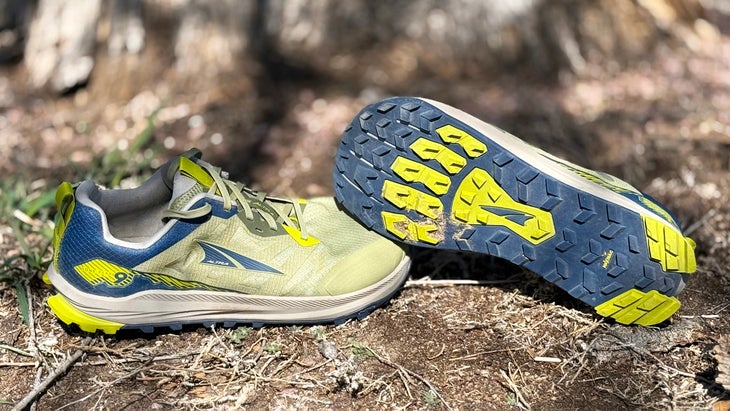
Best Zero Drop
Altra Lone Peak 9
$140 at REI (Women’s) $140 at REI (Men’s)
Weight: 11.1 oz (men), 9.3 oz (women)
Stack Height: 25–25 mm
Drop: 0 mm
Sizing: 7 – 13, 14, 15, 16 (men’s), 5.5 – 12 (women’s)
Pros and Cons
⊕ Retains the best qualities of Lone Peak 8
⊕ Outstanding traction and grip
⊗ New protective toe bumper reduces flexibility in the toe box
“If it ain’t broke, don’t fix it” has been Altra’s motto regarding their flagship trail shoe for years. The Lone Peak 9 stays true to its roots, maintaining the zero-drop platform, wide toe box, and reliable grip, with a few minor updates, including a re-engineered upper, improved outsole, and lighter midsole.
The midsole is still made of Altra EGO foam, but the compound has been reformulated to weigh less and have more resilient compression, so it should last longer. Testers found the changes minimal, with the shoe maintaining its signature flexibility and excellent ground feel.
The upper, which received the lion’s share of updates, features 100 percent recycled ripstop mesh with no-sew overlays. A new protective toe bumper wraps up and extends over the top of the toe box in the front and along the sides. One tester with toe arthritis dinged the new bumper for reducing the flexibility in the toe box, but no other tester noted a problem. One small but clever addition is an additional set of eyelets, spaced farther apart, that allows the option of creating a tighter midfoot hold for those with low-volume feet.
Underfoot, Altra continues to use their proprietary MaxTrac outsole with 3.5-millimeter lugs but increased the rubber coverage for this version. One tester who slogged through the wet, snowy Wisconsin winter described the outsole as “top-notch.” The heel rudder that extends out the back has been split, improving stability by reducing lateral torque. (Note, a version 9+ was recently released that is identical except for a Vibram Megagrip outsole and a new ripstop mesh).
Bottom line: If you’re a Lone Peak fan there’s nothing new here that will jeopardize that. Slight improvements sharpen the ride without altering the shoe’s core identity. “The Lone Peak’s strengths haven’t changed for me,” said one longtime Lone Peak fan.
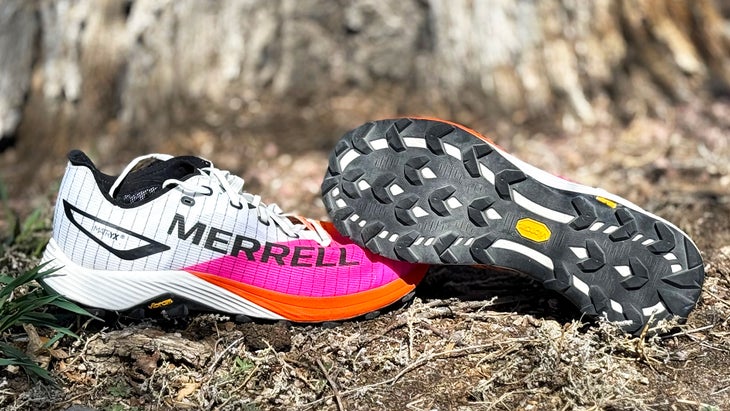
Best For Speedy Scrambles
Merrell MTL Long Sky 2 Matryx
$112 at Backcountry $112 at Merrell
Weight: 8.3 oz (men’s), 6.9 oz (women’s)
Stack Height: 23.5–19.5 mm
Drop: 4 mm
Sizing: 7-15 (men’s), 5-11 (women’s)
Pros and Cons
⊕ Lightweight, low-profile
⊕ Secure foothold
⊕ Nimble over rough terrain
⊗ Cushioning can feel slight under toes
If you’re in need of an amazingly agile shoe to scale mountain trails like a bighorn sheep, the Long Sky 2 Matryx is here for it. The new upper, made out of Matryx—a thin, breathable, quick-drying synthetic fabric reinforced with super-durable Kevlar threads—secures the foot, with a half-booty tongue adding extra hold. Cutouts in the Vibram Megagrip outsole save weight between the tacky, grippy-rubber, five-millimeter lugs. The flexible, compression-molded EVA midsole is on the slight end, enabling confidence-inspiring proprioception and secure footplants on tricky terrain, and firm-but-adequate cushioning on hard-surface trails.
The upper and sole combination locks each stride to the ground. “It is such a lightweight shoe, with great traction and fit, that moving your feet over terrain is easier than in a more bulky, highly-cushioned shoe,” said Lousiville, Colorado-based tester Terri Kazanjian.
This was our go-to shoe for any fast-effort trail runs, or days we craved a highly nimble shoe that felt like an extension of our body. Kanzanjian summed up: “This shoe makes you feel nimble and peppy on technical terrain, like you can run up those hills and bomb those descents faster than normal.”
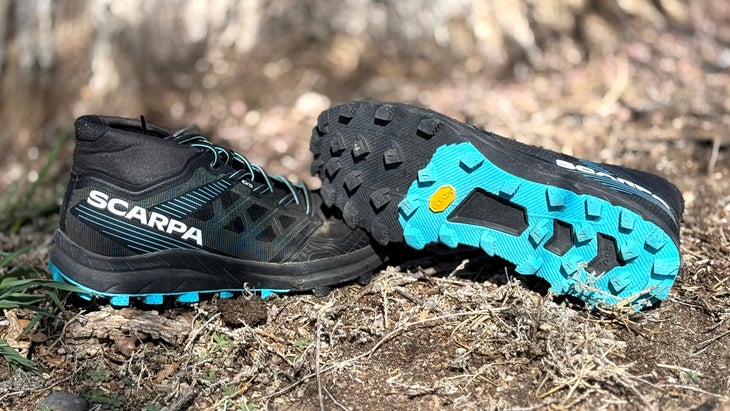
Best for Soft Terrain
Scarpa Spin ST
$179 at Backcountry $179 at Scarpa
Weight: 9.5 oz (men’s), 7.9 oz (women’s)
Stack Height: 22–18 mm
Drop: 4 mm
Sizing: European sizing 40-48 (men’s), 36-43 (women’s)
Pros and Cons
⊕ Effective, toothy grip on soft surfaces
⊕ Low gaiter-link heel collar helps keep out debris
⊗ Harsh ride on hard-packed trails
The “ST” in the name stands for “Soft Terrain,” which is what this shoe is best suited for. Here’s the main reason why: 7 mm(!) lugs made out of Vibram Mega Grip rubber take hold in soft dirt, mud, and snow, offering secure footing on even the sloppiest surfaces. Complementing the toothiness is an impressively secure foothold from PU overlays that encase a stretchy mesh-paneled upper and pull securely around the foot when the laces are tightened. A tester with a bunion on one foot noted the shoe’s narrow and unstretchy toe box caused some irritation but raved about the shoe’s ability to grab hold in soft dirt.
We reached for this shoe often on snowy terrain—either on trails or when snow turned neighborhood roads into trails. The high heel collar made out of a neoprene-like stretch woven textile, which keeps trail debris out of the shoe in summer, also does a good job keeping kicked-up snow from infiltrating socks. The upper isn’t Gore-Tex, however, and doesn’t try to keep water out. Instead, moisture flows both in and out, and we appreciated the breathability on all-season runs where high effort caused hot feet, and for wet conditions when we wanted drainage. A plus: a lace-locking device and hidden lace pocket both eliminates unwanted loosening and snagging on low branches and roots.
With slight EVA cushioning in the midsole (22 mm under the heel and 18 mm under the forefoot), this isn’t a shoe you’d want to wear running hard-packed trails or road sections. But for the soft terrain it was intended for, the underfoot feel was just right, making the Scarpa Spin ST excel at tearing up the trail.
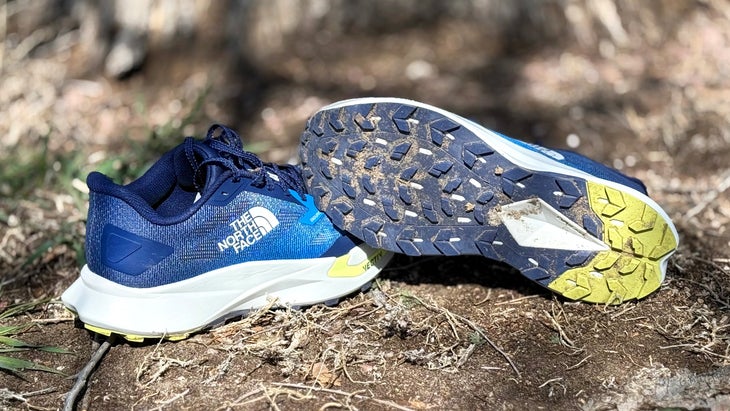
Best For Groomed Trails/Gravel
The North Face Vectiv Enduris 4
$160 at REI $160 at Running Warehouse
Weight: 10.1 oz (men’s), 9 oz (women’s)
Stack height: 32–26 mm
Drop: 6 mm
Sizes: 7-13, 14 (men’s); 5-11 (women’s)
Pros and Cons
⊕ Great balance of stable and cushy
⊕ Propulsive feel
⊗ Can feel tippy on technical terrain
The North Face Enduris 4 is a downright comfortable shoe with a performance ride. Upon step -in, our feet felt cradled, secure, and ready for anything. The shoe excelled on routes like the 5.25-mile dirt-road loop around the Boulder Reservoir that is mostly loose gravel with occasional rocks and ruts. On smoother terrain like that, the super-trainer combination of lively cushioning sandwiched around a full-length TPU plate with rockered geometry made us feel smooth and energetic. The shoe can also handle technical terrain, but the plate makes it feel a tad tippy.
The swallow-tail design—the sole flares out behind the heel with a notch in the middle—seemed to aid a heel-striking gait, cushioning landings and helping to roll feet forward rather than torquing them inward. Traction comes from four-millimeter multidirectional lugs which worked well on a variety of surfaces and didn’t feel too clunky on smooth terrain, although one tester noted, “Mud seemed to stick to the outsole and stay there.” All testers found the seamless engineered mesh upper breathed great and kept feet in place.
Overall, we’re big fans of the updated Enduris 4 with more cush. “The shoe actually felt lighter than expected and easy to run in for both road-to-trail routes and straight trail running,” said one tester.
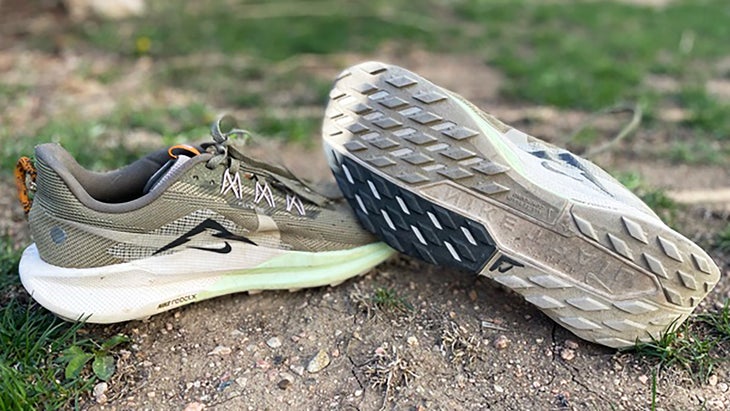
Best Road-To-Trail
Nike Pegasus Trail 5
$150 at REI (Women’s) $150 at REI (Men’s)
Weight: 10.6 oz (men’s), 8.6 oz (women’s)
Stack Height: 37–27.5 mm
Drop: 9.5 mm
Sizes: 6-15 (men’s) 5-12 (women’s)
Pros and Cons
⊕ Transitions well from asphalt to dirt
⊕ Secure fit for off-road confidence
⊕ Good-looking enough for casual wear
⊗ Not as cushioned as some other road-to-trail shoes
The Nike Pegasus Trail 5 is for runners who value a shoe that can take them from home to the trail and back, running smoothly on pavement while offering traction and foothold on even the most technical off-road terrain. What puts this shoe above other road-to-trail options is its superior performance on uneven, rooty, and rocky terrain. Flywire technology (super-strong, thin, and lightweight thread) in the upper kept our feet from sloshing around inside the shoe and helped us maintain quick, secure foot plants. “I felt confident in both the traction and how my feet remained in control on a burly trail with lots of rocks and ups and downs,” said a Boulder, Colorado, tester.
The cushioning is updated in this version to Nike’s smoothly responsive ReactX foam, with a stack soft and thick enough to soften pavement impact, especially under the forefoot. The shoe runs smoothly on roads with its flexible forefoot and 3.5 mm lugs that are hardly noticeable. But when you reach dirt those lugs kick into action and deliver solid traction.
Tightly woven mesh around the toe box adds durability, while strategically placed holes around the midfoot allow breathability. The addition of a looped cord at the heel makes this shoe easy to pull on—a simple feature we appreciated every time we used it.
This shoe also looks fashionable enough to crossover to casual wear, adding to its versatility. “It’s a great shoe for travel that might include hiking, running, walking, and general adventuring,” said our lead tester, who put it through its paces in Colorado and Costa Rica.
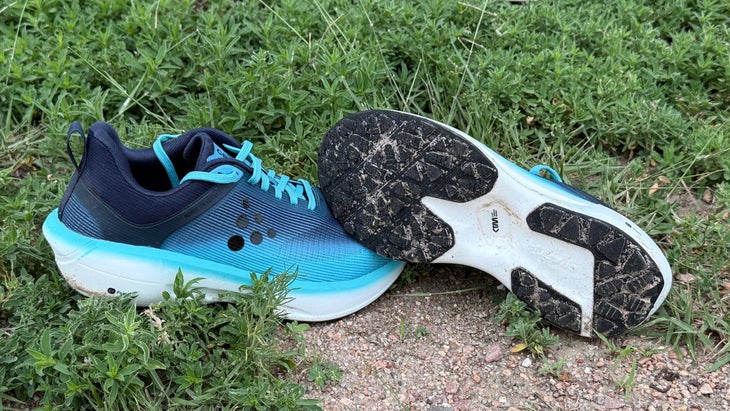
Runner Up Road-to-Trail
Craft Nordlite Ultra 2.0
$180 at Craft (Women’s) $180 at Craft (Men’s)
Weight: 10.9 oz (men’s); 8.9 oz (women’s)
Stack height: 40–34 mm
Drop: 6 mm
Sizes: 8-13 (men’s); 6-10 (women’s)
Pros and Cons
⊕ Ample, responsive cushioning
⊕ Solid traction
⊗ Foothold could be better
We loved the first version of the Nordlite Ultra for its ample and lively midsole, made of reusable materials turned into supercritical foam in a non-toxic process. This second iteration still boasts great cushioning that rivals straight-up road running shoes in shock absorption and rebound. In fact, the Nordlite Ultra 2.0 challenged the Nike Trail Pegasus 5 for the top spot in this category, thanks to that energetic ride. But while this second iteration of the Nordlite Ultra has been updated with a new, more secure-fitting upper, we still feel the lockdown is better on the Nike Trail Pegasus 5, which gives us better control on rugged terrain.
The Nordlite Ultra’s update did improve the fit, however. “It’s snug and secure in the heel, and the tongue is form-fitting and comfortable,” said a Virginia-based tester. “When I was on flat terrain and wearing zero-cushion socks, I felt very comfortable in the shoe.” The secure heel hold gives way to a moderately snug midfoot. It opens up farther in the forefoot, offering wiggle room in the toe box. Cheers to Craft for using recyclable TPU on the upper, adding to the sustainable efforts of this shoe.
Off-road, the Nordlite Ultra 2.0’s traction proved capable on a range of surfaces, although the rubber is a tad noisy on pavement. “The outsole is extremely grippy,” said a tester, “which makes them fun on gravel and when accelerating. They also worked well on a dew-soaked wood boardwalk.” On steep, technical trails and even smooth descents, our feet slipped inside the shoe a bit too much. Still, most road-to-trail routes only cover pavement to moderate trails and back, and these versatile shoes excelled at making both surfaces comfortable and fun.
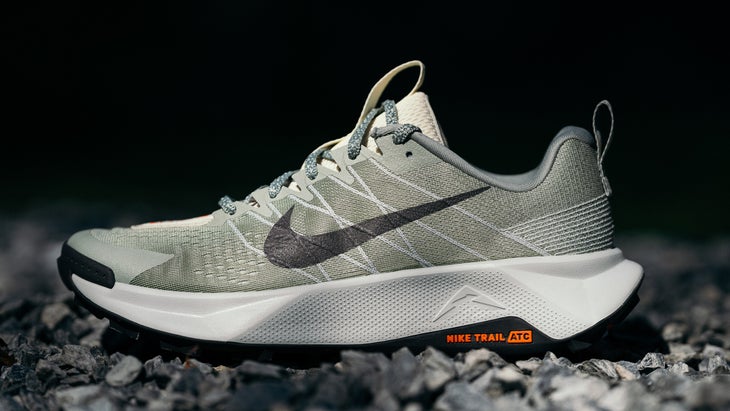
Best Max-Cushioned Trail Shoe
Nike Wildhorse 10
$165 at REI $155 at Backcountry
Weight: 11 oz (men’s); 8.6 oz (women’s)
Stack height: 38–28.5 mm (men’s); 40.3–30.8 mm (women’s)
Drop: 9.5 mm
Sizes: 6-13, 14, 15 (men’s); 5-12 (women’s)
Pros and Cons
⊕ ReactX foam is lightweight and lively
⊕ Secure foothold
⊗ A tad heavy
The Nike Wildhorse 10 takes over top spot from the Brooks Caldera 8 (which we still really like) for its ability to cushion, protect, and provide a super-secure foothold that inspires confidence on even the wildest terrain.
“Love this shoe!” exclaimed a tester based in Louisville, Colorado. “It has fantastic cushioning, great tread, and it’s just all-around comfortable.” She also noted that the cushioning placement of the Wildhorse 10 is unusually prominent on the perimeter. ”I noticed it more on the outer parts of my midfoot, which was new, but I really liked it.”
We’ve loved this shoe for everything from speedy, hilly dawn-patrols to all-day mountain epics. Its secure, comfortable engineered mesh upper moved with our feet more like a skin than a shell, which made us feel nimble over hill and dale (and river and rocky peak). And a protective midsole worked in conjunction with the Wildhorse’s full-ground-contact traction to make it a reliable go-anywhere partner. Traction comes from Nike Trail All Terrain Compound (ATC)—a rubber outsole that works well on steep ups and downs.
The Nike Wildhorse 10 is not the lightest shoe, but for all its cushioning, protection, and agility in rugged terrain, it’s a solid choice. (It may, however, be overkill for flat, smooth trails.)
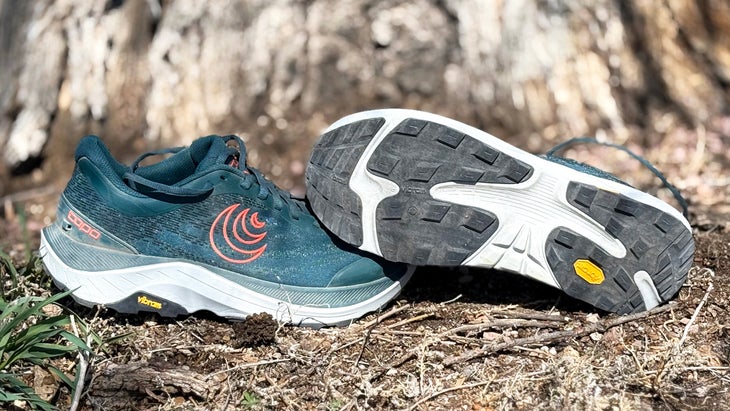
Best Natural Ride
Topo Athletic Ultraventure 4
$150 at REI $150 at Backcountry
Weight: 10.4 oz (men’s), 8.2 oz (women’s)
Stack height: 35–30 mm
Drop: 5 mm
Sizes: 7-13, 14, 15 (men’s); 6.5-12 (women’s)
Pros and Cons
⊕ Instantly comfortable on a variety of feet
⊕ Highly cushioned while still allowing ground feel
⊗ Doesn’t grab loose dirt well
The Topo Athletic Ultraventure 4 fits like a classic Topo shoe—a secure heel hold gives way to a wide toe box allowing the foot to splay out naturally. Even narrow-footed testers noted the secure and comfortable hold of this shoe, and enjoyed the feeling of support under the arch, which seems to further promote a relaxed forefoot.
The Topo Ultraventure 4 has a relatively high stack height and an ample amount of lively cushioning, which testers particularly noticed and appreciated under the ball of the foot. But unlike its high-cush contemporaries, the slightly firm, responsive, flexible midsole allows great feel for the ground. We enjoyed the surefooted feeling of being connected to the trails instead of floating on top of them.
The upper—a recycled mesh with a polyurethane wrap around the front of the shoe for protection from toe stubs—is slightly stretchy and conforms around the foot. “This felt like a slipper with traction,” said one tester.
Underfoot, wide, flat, 3.5-millimeter-deep lugs made of Vibram rubber stuck to steep rock slabs on dry trail runs in Boulder, Colorado, and ran smoothly on packed dirt. We craved a little more toothiness on loose trails, but appreciated the versatility and overall natural feel of this shoe. “The Ultraventure 4 felt better the longer I went and more tired I got, encouraging and supporting a soft midfoot landing and gentle roll that ate up the miles,” said one tester.
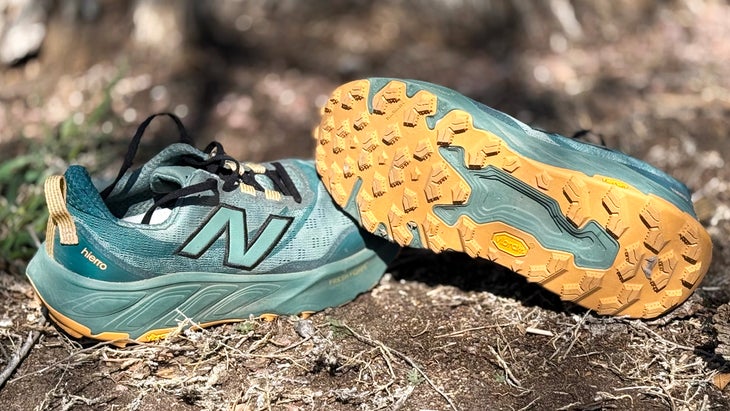
Best For Beginner Trail Runners
New Balance Fresh Foam X Hierro v9
$155 at REI $155 at Backcountry
Weight: 10.3 oz (men), 8.3 oz (women)
Stack Height: 42–38 mm
Drop: 4 mm
Sizing: 7-13, 14, 15, 16, 17 (men’s); 5-11, 12 (women’s)
Pros and Cons
⊕ Both well-cushioned and stable
⊕ Aggressive traction
⊗ Large lugs can feel rough on hard pack
If you’re just getting into trail running, you need a shoe that provides stability, grip, and comfort—in essence, one that makes you more confident on the trail. Testers all agreed the New Balance Hierro v9 fit that bill better than any other shoe we tested. In this version, New Balance used two layers of their EVA-based Fresh Foam X in the midsole—a softer layer closer to the foot for cushioned comfort sits on top of a firmer layer that enhances stability. One tester noted this midsole combo “absorbs shock well and returns energy efficiently.” She also praised the shoe’s forefoot rocker profile, which “makes for a smooth push-off and helps with your forward motion and efficiency.”
Despite having four millimeters more cushioning under the heel (and eight more under the forefoot) than version 8, bringing the total stack to a whopping 42–38 millimeters, we found the Hierro v9 shockingly stable as long as we steered clear of technical terrain—which most beginners tend to do anyway. Grippy 4.5-millimeter lugs—which one tester described as “very aggressive”—instill confidence, particularly on loose dirt and gravelly trails. The downside is that those long lugs contributed to a rough ride on hard-packed dirt or road.
A tough-skinned mesh upper with a gusseted tongue felt supportive, yet provided enough comfort for all-day use. All in all, the combination of a thick stack of soft cushioning, grippy outsole, and comfortable and secure upper make this a standout choice for beginner trail runners eager to explore.
How to Choose a Trail Running Shoe
If you’re in the market for a trail running shoe, first consider the type of trails you run on regularly: do you tackle rugged, mountainous terrain, or stick to mellow dirt paths? Some trail shoes can handle both adequately, while others are specialized and excel in one or the other. Shoes with smaller lugs are generally better on smoother, firmer terrain, whereas shoes with deeper, more aggressive outsoles are optimized for steep, muddy, or rocky trails. If you like to feel the trail and dance around rocks and roots, you’ll likely prefer a light, more minimal shoe, but if you’d rather let the shoe roll over trail variations, cushioning and protecting while you zone out, you should look for a shoe with a thicker midsole.
Once you’ve narrowed the search to a certain type of trail shoe, you need to find a pair that complements your unique body and stride. Every runner’s body, gait, speed, experience, and ride preferences are different, so every runner will interact differently with each trail shoe. The shoe that your best friend or your sister-in-law loves may be uncomfortable for you and make running feel slow, sluggish, or even painful. Finding the perfect pair of trail running shoes is a seriously personal affair.
The process for choosing the best running shoes is a matter of finding the models that both fit your foot and also feel best when you’re running. To determine fit and feel, there’s no substitute for trying the shoes on and running in them.
Fit: Match Your Foot Shape
When assessing fit, first pay attention to length. You need room at the end of your toes as your feet lengthen during their dynamic movements on the run. A rule of thumb is to allow a thumb’s width between your longest toe and the end of the shoe. Runners often wear a running shoe a half or full size bigger than their street shoes.
Ensure that the shape of the sole and the upper matches your foot shape. The sole should be as wide or wider than your foot for the whole length, and match the curve of your arch comfortably. The shoe should hold your foot securely over the instep, while allowing the ball of the foot and the toes to splay and flex when you roll forward onto them. Your heel shouldn’t slip when you lift it, and the arch should be able to dome and lengthen naturally. Nothing should bind or rub as you roll through the stride.
Feel: Match Your Movement Path
If the shoe fits, it’s time to take them on a short run on a treadmill, around the store, or, ideally, down the block and back. Every running shoe has a unique ride created by the type and density of foam in the midsole and the geometry of that foam: its thickness, width, heel-to-toe drop, molded sidewalls or flares, and forefoot flexibility or rocker shape (plus, in an increasing number of models, the presence of and type of embedded plate). Each of these elements interact with each other and your stride to determine how the shoe reacts on landing, how much it cushions, how stably it supports, how smoothly it transitions from landing to toe off, and how quickly and powerfully it rebounds.
The best way to choose the shoes that complement your body and stride is to find the ones that feel right on the run. Benno Nigg, the world-leading biomechanics professor who proposed this method of shoe selection, calls it the “comfort filter,” but makes clear it is far more than how plush the shoe feels when you step into it. What you want to assess is whether the shoe allows and supports the way your feet want to move, what Nigg calls your “preferred movement path.” In the right shoe, while running at your normal pace, you will touch down where you expect to land, roll smoothly and stably through the stride without noticing the shoe, feel both cushioned from and connected to the ground, and push off naturally, quickly, and powerfully. When this comes together you’ll know that you’ve found your pair.
It’s likely that several shoes will feel good on your feet. To find the most comfortable, it helps to compare them back to back, like an eye doctor will do with corrective lenses: flipping between “A” or “B,” “1” or “2.” You may also find that different shoes feel better at different paces or level of fatigue, and you may want more than one pair. In fact, research shows that wearing a variety of different shoes is one of the few proven ways to reduce injury risk as it appears to vary the stresses on your feet and joints.
What About Injury Prevention?
Running shoes have long been marketed and sold as prescriptive devices to help runners stay healthy, but there is little scientific evidence correlating shoes, or any specific shoe properties—like cushioning or pronation control—with running injuries. Medical professionals say that it is highly difficult to determine whether a runner needs a certain type of shoe, and studies have shown that prescribing shoes using traditional methods like treadmill gait analyses or wet-foot arch height tests don’t consistently reduce injuries.
Don’t assume that you need more cushioning or more stability if you have sore joints, or if you’re a heavier runner, or if you’re a beginner—evidence doesn’t support many common beliefs. The best way prevent injury is find two or three different pairs that feel right on the run, ease into using them, and vary your shoes, your running surface and your pace regularly (plus avoid rapid increases in your training load and work on improving your mechanics).
How We Test
- Number of testers: 18
- Number of shoes tested: 108
- Number of miles: 22,000+ over a year
- Most Memorable Trail Run: Having a mild winter afternoon turn into a blizzard while three miles from home in the western Nebraska sandhills.
To test running shoes, we begin by researching every brand’s new offerings for the coming season. We wind up with dozens of samples of the models (84 throughout the year, 34 trail running shoes this season) that are most promising, and distribute them to 26 testers who range in age, ability, running form, geographical location, terrain, and preferred shoe types. We try to put each tester in shoes from within the same category (all rugged, backcountry trail shoes, or all road-to-trail crossovers) so everyone can test apples-to-apples.
After three to six months of running in each model on varied terrain and in all conditions, our crew members report back with their assessments of fit, comfort, traction, cushioning, flexibility, stiffness, pop, what type of running the model is best used for, how the shoe compares to other models, and more. We also run in every trail running shoe ourselves, and, combining all the tester feedback with years of personal experience, hone in on the best. We then weigh this season’s bests against the heroes from previous seasons that are still available and choose winners and honorable mentions for each category.
Meet Our Lead Testers
Lisa Jhung
Freelance journalist, editor, and author Lisa Jhung has researched, tested, and written about running shoes for the past decade and a half, much of that time for Outside. She coordinates a fleet of female shoe testers out of Boulder, Colorado, and says her home office is a perpetual obstacle course of cardboard boxes and piles of running shoes. Lisa’s written about gear of all kinds for numerous national magazines as both an editor and freelancer, including a stint as the shoes and gear blogger and trail running microsite editor for Runner’s World.
A high school jumper and occasional sprinter/hurdler, she started running—really running—after walking off the collegiate volleyball team, and moved on to road and trail races of any distance, triathlons, adventure races, and mountain running. She’s happiest testing rugged trail shoes on gnarly terrain, and also loves a good neighborhood jaunt…but is almost always looking for ribbons of dirt. Lisa is the author of Running That Doesn’t Suck: How to Love Running (Even if You Think You Hate It) and Trailhead: The Dirt on All Things Trail Running.
Cory Smith
Cory’s passion for running started over 30 years ago in high school when he became the number six ranked runner in the nation at 3000 meters his senior year. After high school, he competed at Villanova University, earning two NCAA Division I Championship showings. Today, he’s determined not to let age slow him down and competes on the national master’s circuit, running a 4:12 (4:30 mile pace) 1500 meters and 9:04 (4:52 mile pace) 3000 meters in 2021 at age 43. He prefers a hard track workout or tempo run over an easy long run any day but also appreciates a challenging trail or mountain run.
His obsession with running shoes started in 2014 when he wrote his first shoe review for Gear Institute. Since then, he’s tested and reviewed hundreds of running shoes, clothing, and gear for Outside, Runner’s World, Footwear News, and other outlets. He has a soft spot for speedy shoes over heavy trainers but loves dissecting all shoes equally and thinking like a product engineer to explain the why behind every design detail. Cory is the Founder of Run Your Personal Best, an online running coaching business, and since its inception in 2014, has coached runners’ to over 100 Boston Marathon Qualifying times.
One of Cory Smith’s go-to routes for testing trail running shoes:
Jonathan Beverly
Jonathan fell in love with running his freshman year of high school and quickly became fascinated with finding the perfect pair of running shoes. That quest got a boost when he became editor of Running Times in 2000 and started receiving every new model as they were released. The parade of shoes continued while he served as shoe editor for Runner’s World, then editor of PodiumRunner, and currently fitness gear editor at Outside. Having now worn nearly every running shoe created in this century—and a fair amount of those dating back to the early models of the ’70s—he’s given up on finding the one best and now relishes the wide variety of excellent options.
Once a 2:46 marathoner regularly doing 50+ mile weeks, recent injuries and his age have reduced his volume and slowed his pace—but he still enjoys an uptempo workout or two each week. Beverly is the author of the book Your Best Stride which explores how each individual’s gait—and thus shoe preference—is unique. He enjoys getting scientists’ take on new shoe trends and trying to describe the nuances of each shoe’s ride.
One of Jonathan Beverly’s go-to routes for testing trail running shoes:



